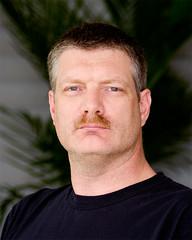Let me start off this post with an apology for the large gap between posts in this series. The gap is so long that I recommend you quickly preview the previous article in the Wireless P-TTL series, Single Strobe Lighting (Preparation), so you can get caught back up. I know I had to read again it so there would be some sense of flow between the articles.
For this single strobe shot the light was placed halfway between the camera and the subject and the lens. I wanted a relatively large light source so I had to put the umbrella up close. The camera was positioned to shoot under and to the right of the umbrella which is just off frame enough for the lens hood to block the flare. The on camera flash was fired in this shot (accidentally actually) but added an almost ring light appearance seen in fashion shots that make the face kind of glow. It did however add a shadow to the background (seen just to the left of the subject).
As you can see it is quite possible to get good and usable results with just a single strobe and in this case, fill from your built in flash.
In this shot I set the built-in flash to not fire during the capture. This is commander mode. You can see the difference, the glow is different as there is no spectral lighting reflected off the face. It is lacking the "ring light" look but still a decent enough image to make a print of. At least my wife thinks so. ;)
If you wanted a little more contrast ratio on the face then just move the umbrella more to one side. You can position the light at the more traditional 45 degrees (side and up) for the Rembrandt look and use a white foam core or poster board as reflected fill. The possibilities are almost endless, especially if you incorporate some outdoor light into the shot.
These images were captured at f4 ISO 100 and the default shutter speed of 1/180. If you wanted to brighten up the background then you could drag the shutter a little to allow more ambient light on the sensor. This will have no affect on the strobe light as that is controlled solely by the aperture of the lens. However, if there was any ambient falling on the subject (as was the case here - shot under the carport on the north side of the house) then it will affect that lighting also. I wanted f4 to blur the background and any faster shutter speed would have made the background too dark. Any slower and the ambient would have taken precedence on the face. So we get what we get in the middle ground.
In the next article we'll talk about using a background light to get some separation between subject and background and even use the same light to provide a little kicker. See you then!




No comments:
Post a Comment